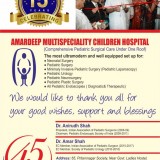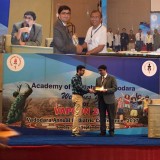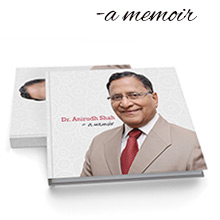INFORMATION AVAILABLE IN ENGLISH , GUJARATI AND HINDI
Syndactyly :
Syndactyly means ‘joined digits’ and may involve webbing of the skin, or include fusion of the underlying bones. This may be along part or the whole length of the finger. It is the second most common congenital hand problem and occurs in around 1 in 1000 births.
Hand development occurs in the early stages of pregnancy and the fingers separate in the ninth week. Syndactyly happens when two or more fingers fail to completely separate during development.
Sometimes syndactyly occurs by chance or it may be inherited. In rare circumstances, it may occur along with other signs as part of a syndrome (collection of signs).
Syndactyly can occur unilaterally (on one hand only) or bilaterally (affecting both hands), and can affect two or more fingers. Occasionally it may be associated with extra digits or other abnormalities in the hands.
Syndactyly can also affect the toes, involving webbing of the skin or fusion of the underlying bones along part or the whole length of the toe.
How is syndactyly treated?
It is treated surgically under a general anaesthetic. Surgery is usually only possible to one side of a finger at a time, as any damage to the blood supply on both sides could result in the loss of the finger. So, if your child has syndactyly of three or more digits next to each other, they will need more than one operation.
Are there any alternatives to surgery?
Surgery is the only option to separate the digits. The aim of the operation is to improve function (how well your child can use their hand) and sometimes appearance (how your child’s hand looks).
Occasionally, some children could manage without treatment. Correction of toe syndactyly is usually for cosmetic rather than functional reasons.
What does the operation involve?
The surgeon will recreate a new web with local flaps of skin from the sides of the digits. This usually involves making a series of zig-zag incisions along the digits, and wrapping the zig-zag pieces of skin to cover up the inside surface of the digits where they were previously joined.
In most cases, the surgeon will need to use a skin graft to cover up any gaps. This will be a different colour on the hand than the rest of the skin. Occasionally, a skin graft will not be needed.
Are there any risks?
There is a risk of infection as the skin is opened, but your child will be given antibiotics to reduce the risk of this. If an infection does occur, it is usually minor and easily treated with a course of antibiotics.There is a chance that the skin graft will not ‘take’, but looking after it carefully will help the operation site to heal as well as possible. Any infection or graft loss may affect the time the wounds take to heal and therefore the resulting scars.
The amount of scarring varies from child to child. If your child tends to scar easily from cuts and grazes, it is likely that they will have noticeable scars after the operation, but these will fade in time.
What happens after the operation?
Their hand or foot will be covered in a large bandage to protect the skin grafts while they heal. Your child will soon find a way to use their bandaged hand or foot in everyday activities. It is best to keep the limb operated on raised above the level of the heart as much as possible to reduce any swelling, which in turn reduces any pain.It also minimises any oozing under the flaps and skin grafts. Your child’s limb may be raised using pillows or soft toys, or the hand may be placed in a sling when sitting or walking around.If your child’s fingertips or toes are visible, check them on a regular basis for warmth, colour, sensation, movement and blood flow. These checks show that the blood is flowing properly.
What is the outlook for children with syndactyly?
This depends on the degree of syndactyly and whether it occurred by chance or as part of a syndrome. The outlook for children with simple syndactyly is usually excellent. If the syndactyly occurred as part of a syndrome, the outlook depends on the particular syndrome and associated features.
Polydactyly:
Polydactyly is a condition where the child has supernumary fingers or toes. It can present in either one or both hands and / or feet. Most of the times the extra digit is usually a piece of soft tissue on a tiny stalk. Sometimes, it may contain bone without joints and rarely it may be a complete functioning digit.
Surgery for polydactyly is recommended between 1 – 1 1/2 years of age. A rudimentary accesory digit may sometimes undergo torsion needing an emergency surgery. ●
GUJARATI
બાળકની આંગળીઓની ખોડ
બાળકનાં હાથ અને પગની આંગળીઓમાં ઘણી ખોડ જાવા મળે છે. જા એક-બે આંગળીઓની ખોડ હોય તો સર્જરીનાં રીઝલ્ટ સારા આવે છે પણ ઘણી વખત હાથ કે પગની આંગળીઓની સાથે તેમાં રહેલાં હાડકાં પણ ખોડ વાળા હોય તો બાળક આ ખોડ સાથે સારું કામ કરી શકે તેવી સર્જરી કરવામાં આવે છે. આમાં સંપૂર્ણ નોર્મલ દેખાય તેવાં હાથ નથી કરી શકાતા.
આ ખોડ ૧ ૧/૨ વર્ષની આસપાસ આૅપરેશન દ્વારા છૂટી કરી શકાય છે.
હાથ કે પગમાં પાંચ આંગળીઓ કરતાં વધુ હોય તો તેને પોલીડેક્ટલી કહેવામાં આવે છે. સામાન્ય રીતે એક્સ્ટ્રા આંગળીઓ કાઢવાની સર્જરી ૧ વર્ષ પછી કરાવવી, પણ જા એક્સ્ટ્રા આંગળી ફક્ત ચામડીથી જાડાયેલી હોય અને તેમાં વળ ખાઈ ગેંગરીન થાય છે તો તે માટે તાત્કાલિક આૅપરેશન કરાવવું પડે છે. •
HINDI
बच्चों की अंगुलियों की विसंगति
सींडेक्टली अर्थात ‘जुड़ी हुई अंगुलियाँ’ वह स्थिति है जब बच्चे के विकास के दौरान दो या दो से अधिक अंगुलिया पूरी तरह से अलग नहीं हो पाती है। कभी-कभी कुछ बच्चे बिना किसी उपचार के भी कार्य कर सकते है। पैर के अंगूठे के सिंडेक्टिली का उपचार आमतौर पर कार्यात्मक कारणों से अधिक कॉस्मेटिक कारणों से किया जाता है (ताकि बच्चा चप्पल/स्लीपर पहन सके)। सर्जरी के लिए कभी-कभी त्वचा निरोपन की आवश्यकता पड़ती है।
पॉलीडेक्टीलीमें बच्चे को अतिरिक्त अंगुलियाँ अथवा अंगूठे होते हैं। यह एक या दोनों हाथ अथवा पांव में हो सकती है। अधिकतर मामलों में ये अतिरिक्त अंगुलियाँ छोटे से डंठल पर नर्म मांस-तंतु के समान होती हैं। कभी-कभी इनमें बिना किसी जोड़ के हड्डी होती है; और यह शायद ही कभी पूर्णतया कार्यशील अंगुली के रूप में होती है। सींडेक्टली के लिए सर्जरी १भ वर्ष की आयु होने पर की जाती है। अतिरिक्त अंगुली केवल त्वचा से जुड़ी हो और इसमें मरोड़ उत्पन्न हो जाए तो यह एक आपात स्थिति पैदा कर सकती है। •




